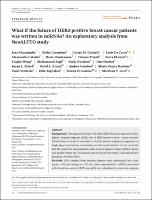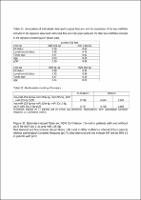| dc.contributor | Vall d'Hebron Barcelona Hospital Campus |
| dc.contributor.author | Cosentino, Giulia |
| dc.contributor.author | Cataldo, Alessandra |
| dc.contributor.author | Plantamura, Ilaria |
| dc.contributor.author | Nuciforo, Paolo Giovanni |
| dc.contributor.author | Ciniselli, Chiara Maura |
| dc.contributor.author | Pizzamiglio, Sara |
| dc.contributor.author | De Cecco, Loris |
| dc.date.accessioned | 2022-06-27T12:01:27Z |
| dc.date.available | 2022-06-27T12:01:27Z |
| dc.date.issued | 2022-01 |
| dc.identifier.citation | Pizzamiglio S, Cosentino G, Ciniselli CM, De Cecco L, Cataldo A, Plantamura I, et al. What if the future of HER2-positive breast cancer patients was written in miRNAs? An exploratory analysis from NeoALTTO study. Cancer Med. 2022 Jan;11(2):332–9. |
| dc.identifier.issn | 2045-7634 |
| dc.identifier.uri | https://hdl.handle.net/11351/7731 |
| dc.description | HER2; MicroRNA; Trastuzumab |
| dc.description.abstract | Background
Neoadjuvant therapy with dual HER2 blockade improved pathological complete response (pCR) rate in HER2-positive breast cancer patients. Nevertheless, it would be desirable to identify patients exquisitely responsive to single agent trastuzumab to minimize or avoid overtreatment. Herein, we evaluated the predictive and prognostic value of basal primary tumor miRNA expression profile within the trastuzumab arm of NeoALTTO study (ClinicalTrials.gov Identifier: NCT00553358).
Methods
RNA samples from baseline biopsies were randomized into training (n = 45) and testing (n = 47) sets. After normalization, miRNAs associated with Event-free survival (EFS) and pCR were identified by univariate analysis. Multivariate models were implemented to generate specific signatures which were first confirmed, and then analyzed together with other clinical and pathological variables.
Results
We identified a prognostic signature including hsa-miR-153-3p (HR 1.831, 95% CI: 1.34–2.50) and hsa-miR-219a-5p (HR 0.629, 95% CI: 0.50–0.78). For two additional miRNAs (miR-215-5p and miR-30c-2-3p), we found a statistically significant interaction term with pCR (p.interaction: 0.017 and 0.038, respectively). Besides, a two-miRNA signature was predictive of pCR (hsa-miR-31-3p, OR 0.70, 95% CI: 0.53–0.92, and hsa-miR-382-3p, OR: 1.39, 95% CI: 1.01–1.91). Notably, the performance of this predictive miRNA signature resembled that of the genomic classifiers PAM50 and TRAR, and did not improve when the extended models were fitted.
Conclusion
Analyses of primary tumor tissue miRNAs hold the potential of a parsimonious tool to identify patients with differential clinical outcomes after trastuzumab based neoadjuvant therapy. |
| dc.language.iso | eng |
| dc.publisher | Wiley |
| dc.relation.ispartofseries | Cancer Medicine;11(2) |
| dc.rights | Attribution 4.0 International |
| dc.rights.uri | http://creativecommons.org/licenses/by/4.0/ |
| dc.source | Scientia |
| dc.subject | Mama - Càncer - Aspectes genètics |
| dc.subject | Marcadors tumorals |
| dc.subject | Mama - Càncer - Tractament |
| dc.subject.mesh | Breast Neoplasms |
| dc.subject.mesh | /genetics |
| dc.subject.mesh | Neoadjuvant Therapy |
| dc.subject.mesh | Biomarkers, Tumor |
| dc.title | What if the future of HER2-positive breast cancer patients was written in miRNAs? An exploratory analysis from NeoALTTO study |
| dc.type | info:eu-repo/semantics/article |
| dc.identifier.doi | 10.1002/cam4.4449 |
| dc.subject.decs | neoplasias de la mama |
| dc.subject.decs | /genética |
| dc.subject.decs | tratamiento neoadyuvante |
| dc.subject.decs | marcadores tumorales |
| dc.relation.publishversion | https://doi.org/10.1002/cam4.4449 |
| dc.type.version | info:eu-repo/semantics/publishedVersion |
| dc.audience | Professionals |
| dc.contributor.organismes | Institut Català de la Salut |
| dc.contributor.authoraffiliation | [Pizzamiglio S, Ciniselli CM] Bioinformatics and Biostatistics Unit, Department of Applied Research and Technological Development, Fondazione IRCCS Istituto Nazionale dei Tumori, Milan, Italy. [Cosentino G, Cataldo A, Plantamura I] Molecular Targeting Unit, Department of Research, Fondazione IRCCS Istituto Nazionale dei Tumori, Milan, Italy. [De Cecco L] Integrated Biology Platform, Department of Applied Research and Technological Development, Fondazione IRCCS Istituto Nazionale dei Tumori, Milan, Italy. [Nuciforo P] Molecular Oncology Group, Vall d'Hebron Institute of Oncology (VHIO), Barcelona, Spain |
| dc.identifier.pmid | 34921525 |
| dc.identifier.wos | 000731256000001 |
| dc.rights.accessrights | info:eu-repo/semantics/openAccess |


